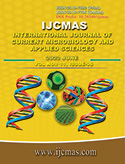


 National Academy of Agricultural Sciences (NAAS)
National Academy of Agricultural Sciences (NAAS)

|
PRINT ISSN : 2319-7692
Online ISSN : 2319-7706 Issues : 12 per year Publisher : Excellent Publishers Email : editorijcmas@gmail.com / submit@ijcmas.com Editor-in-chief: Dr.M.Prakash Index Copernicus ICV 2018: 95.39 NAAS RATING 2020: 5.38 |
Biosynthesis of nanoparticles from plant-based sources has been proven to be cost efficient and eco-friendly. Due to its miniature size, nanoparticles have a higher surface area to volume proportion, which is very important for its insecticidal potentiality. Hence nanoparticles could be used as an important tool for pest management. The main objective of this study was to provide a better management strategy through analysing, evaluating and proving the bioefficacy of Azadirachta indica and Pongamia pinnata silver nanoparticles against 1st nymphal instars of A. devastans under laboratory conditions. Silver green nanoparticles were synthesized biologically from leaf extracts of A. indica and P. pinnata by Sunlight mediated exposure method and studied its bio efficacy on A. devastans. Characterization of the nanoparticles were done by UV-Visible spectroscopy for confirming the formation of nanoparticles and Particle Size Analyser (PSA) for determining size and distribution of particles. Surface Electron Microscope (SEM) was used for determining the surface topography of nanoparticles. The results obtained from Particle Size Analyzer (PSA) showed that A. indica and P. pinnata based AgNo3 nanoparticles had an average diameter of 61.70 nm and 68.80 respectively. Even though both A. indica and P. pinnata based silver nanoparticles caused cent per cent nymphal mortality at 2000 ppm, A. indica based nanoparticles were found to be comparatively more efficient and having higher insecticidal activity against A. devastans at lower concentrations. Nymphal mortality was found to be positively correlated with increase in concentration of nanoparticles. Symptoms caused by silver nanoparticles were dehydration, inactiveness, brittleness etc.
 |
 |
 |
 |
 |